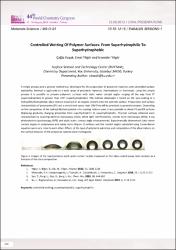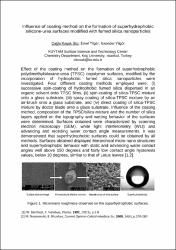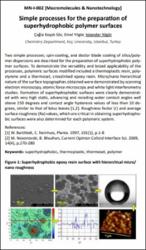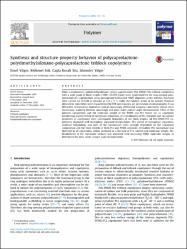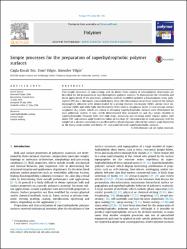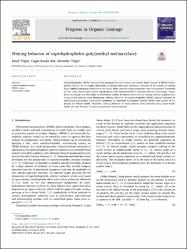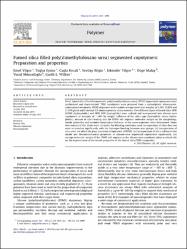Ara
Toplam kayıt 14, listelenen: 1-10
From superhydrophilic to superhydrophobic: tunable wetting of polymer surfaces through the use of fumed silica
(2016)
A simple process and a general method was developed for the preparation of polymeric materials with controlled surface wettability. Method is applicable to a wide range of polymeric materials, thermoplastic or thermoset. ...
Influence of coating method on the formation of superhydrophobic silicone-urea surfaces modified with fumed silica nanoparticles
(2015)
Effect of the coating method on the formation of superhydrophobic polydimethylsiloxane-urea (TPSC) copolymer surfaces, modified by the incorporation of hydrophobic fumed silica nanoparticles were investigated. Four different ...
Superhydrophobic polymer surfaces: preparation, properties, and applications
(Smithers Rapra Technology, 2016)
Surface properties have critical roles in determination of the durability and overall performance of polymeric materials for applications in many fields. Recent investigations on naturally superhydrophobic surfaces such ...
Simple processes for the preparation of superhydrophobic polymer surfaces
(2017)
Two simple processes; spin-coating, and doctor blade coating of silica/polymer dispersions are described for the preparation of superhydrophobic polymer surfaces. To demonstrate the versatility and broad applicability of ...
Synthesis and structureproperty behavior of polycaprolactone-polydimethylsiloxane-polycaprolactone triblock copolymers
(Elsevier, 2016)
Poly(ε-caprolactone)–polydimethylsiloxane–poly(ε-caprolactone) (PCL-PDMS-PCL) triblock copolymers with a wide range of block lengths (1000–32,000 g/mol) were synthesized by the ring-opening polymerization of ε-caprolactone ...
Simple processes for the preparation of superhydrophobic polymer surfaces
(Elsevier, 2016)
Two simple processes; (i) spin-coating, and (ii) doctor blade coating of silica/polymer dispersions are described for the preparation of superhydrophobic polymer surfaces. To demonstrate the versatility and broad applicability ...
Wetting behavior of superhydrophobic poly(methyl methacrylate)
(Elsevier, 2018)
Superhydrophobic PMMA surfaces were prepared by spin-coating and doctor blade coating of PMAA/hydrophobic silica (1/10 by weight) dispersions in toluene onto glass substrates. Influence of the number of coating layers ...
Fumed silica filled poly(dimethylsiloxane-urea) segmented copolymers: Preparation and properties
(Elsevier, 2011)
Novel fumed silica filled thermoplastic poly(dimethylsiloxane-urea) (TPSU) segmented copolymers were synthesized and characterized. TPSU copolymers were prepared from a cycloaliphatic diisocyanate, aminopropyl terminated ...
Effect of filler content on the structure-property poly(ethylene oxide) based polyurethaneurea-silica nanocomposites
(Wiley, 2017)
Poly(ethylene oxide) (PEO) based polyurethaneurea‐silica nanocomposites were prepared by solution blending and characterized by Fourier Transform Infrared Spectroscopy, Scanning Electron Microscopy, Differential Scanning ...
Polyurethaneurea–silica nanocomposites: Preparation and investigation of the structure–property behavior
(Elsevier, 2013)
Nanocomposites consisting of thermoplastic polyurethane–urea (TPU) and silica nanoparticles of various size and filler loadings were prepared by solution blending and extensively characterized by Fourier transform infrared ...

